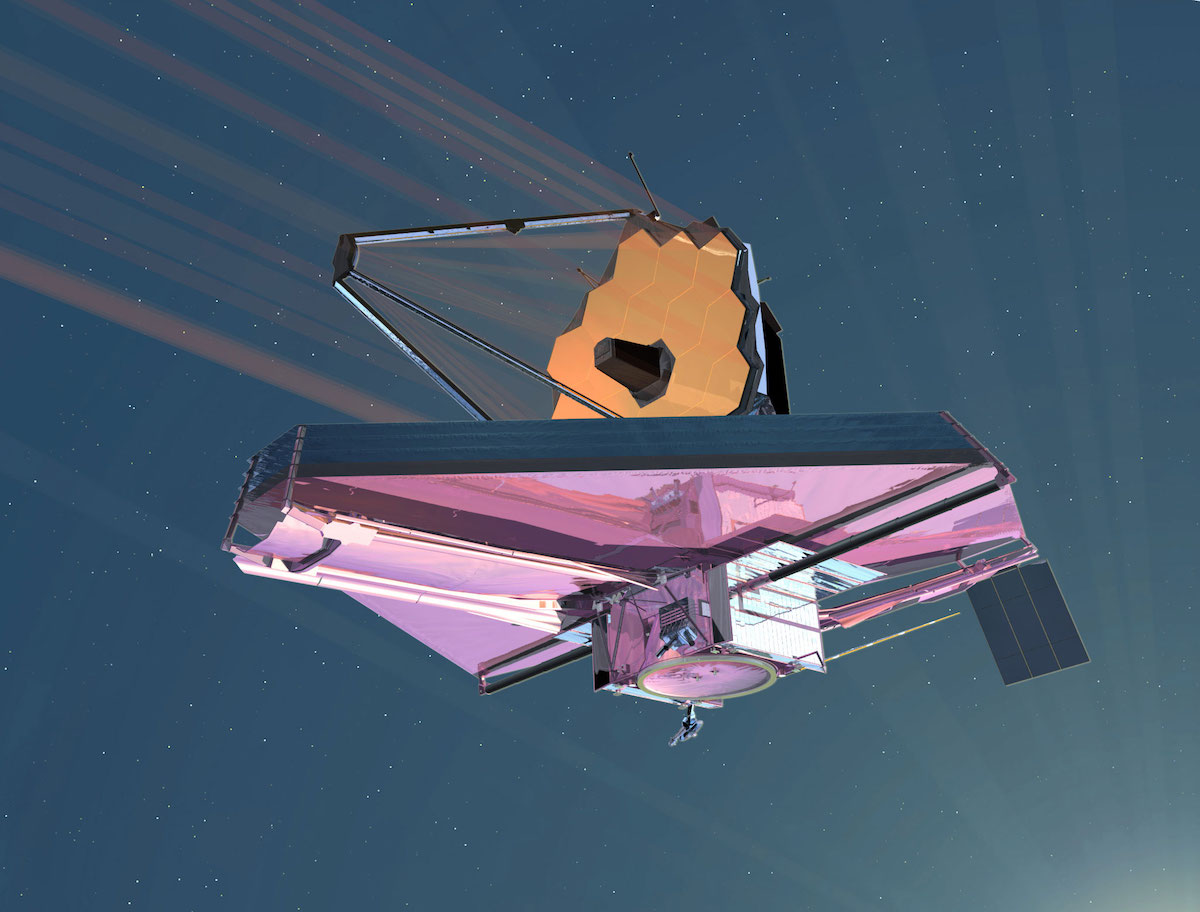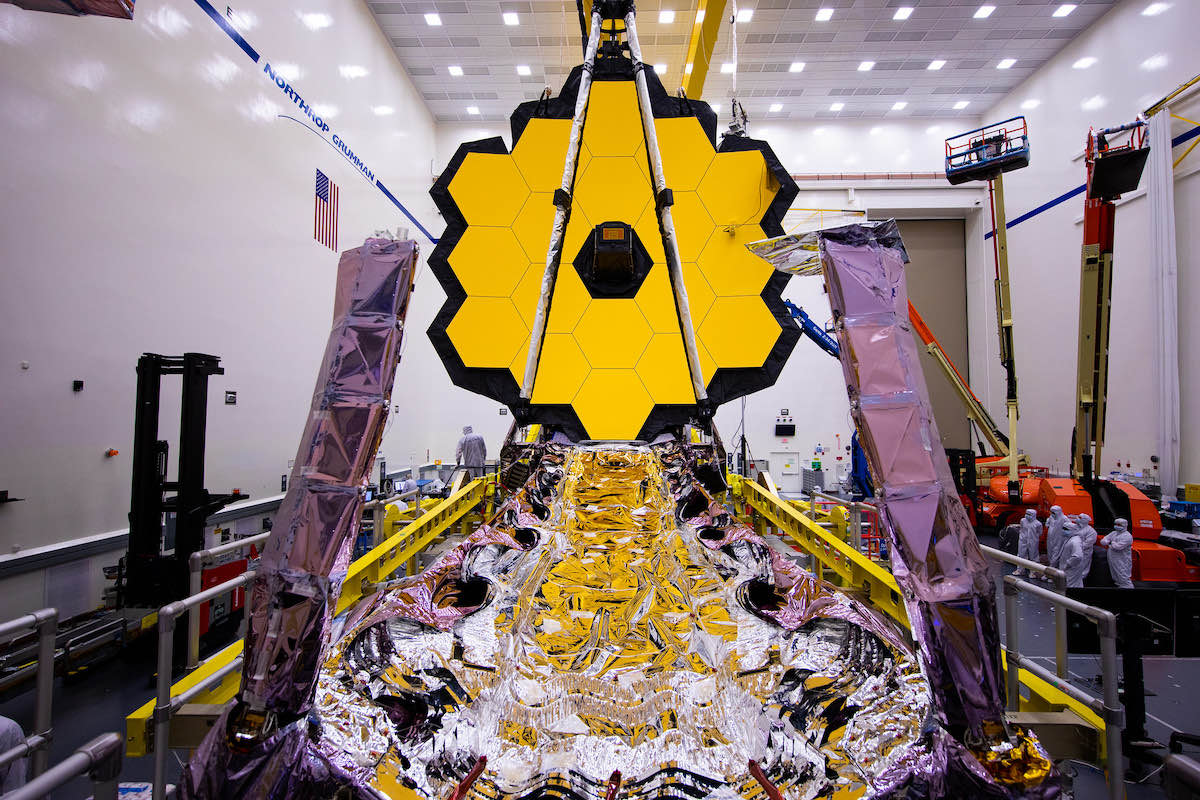
Still cruising toward its operating orbit nearly a million miles from Earth, the $10 billion James Webb Space Telescope completed a transformation into its final dimension Saturday with the last of some 50 post-launch deployments, the unfolding of the observatory’s 21.3-foot (6.5-meter) primary mirror.
Mission controllers at the Space Telescope Science Institute in Baltimore, Maryland, confirmed the starboard, or right-side wing of Webb’s primary mirror had folded into place at 10:28 a.m. EST (1528 GMT) Saturday. The milestone occurred 14 days, 3 hours, and 8 minutes after the mission’s launch Dec. 25 from French Guiana aboard a European Ariane 5 rocket.
A few hours later, ground teams announced the mirror wing had fully latched into place, prompting high-fives, applause, and cheers among the control team in Baltimore, all wearing face masks amid a wave of worldwide coronavirus infections.
“We have a full deployed JWST observatory,” said Paul Reynolds, deployment operations lead from Northrop Grumman, Webb’s primary contractor.
The unfolding of the starboard wing Saturday followed a similar series of events Friday with the port-side mirror wing. Each folding appendage holds three of Webb’s 18 hexagonal primary mirror segments, while 12 of the mirror sections are mounted to the fixed central structure of the telescope.
“Today has been a really remarkable day,” said Bill Ochs, NASA’s Webb project manager, in a press briefing Saturday. “We still have about five-and-a-half months of commissioning left, but the last two weeks have been truly amazing … The success of the last two weeks is truly a tribute to the people of the JWST program. Their diligence and passion for JWST is second to none.”
The mirror deployment capped 14 days of deployments since Webb’s launch, when it was folded up like an origami inside the Ariane 5 payload fairing.
Webb deployed its solar panel moments after separating from its launcher, and then folded open a high-gain antenna to improve communications with ground teams on Earth.
The observatory then deployed two large pallet structures containing the mission’s sunshield, a thermal barrier designed to keep Webb’s mirrors and science instruments at super-cold temperatures, nearly minus 400 degrees Fahrenheit.
On New Year’s Eve, controllers uplinked commands for Webb to extend two booms from each side of the spacecraft. The booms pulled out the five-layer sunshield like a blanket until it reached its full size, roughly equivalent to the area of a tennis court. The deployment plunged the telescope’s mirrors into permanent darkness, allowing temperatures to begin dropping down to Webb’s operating conditions.
Last week, ground teams monitored the careful tensioning of all five layers of the sunshield. Each membrane, as thin as a human hair, is made of kapton and treated with aluminum to reflect heat.
Webb’s secondary mirror support structure deployed on a tripod-like apparatus Wednesday, Jan. 5, and a radiator opened on the back side of the observatory’s instrument module Thursday, clearing the way for the final primary mirror wing deployments Friday and Saturday.
“We have a fully deployed JWST observatory.”
Mission control in Baltimore, Maryland, has confirmed the Webb telescope’s primary mirror is latched, completing the mission’s complex deployments since launch Dec 25.https://t.co/phLEclX8tM pic.twitter.com/C8rvyrxE1C
— Spaceflight Now (@SpaceflightNow) January 8, 2022
For many engineers, the unfolding of the Webb observatory was the most complicated series of spacecraft deployments ever attempted.
“There are two unique things about the deployments,” said Mike Menzel, Webb’s mission systems engineer at NASA’s Goddard Space Flight Center. “First was the sunshield, and that was deploying large indeterministic foppy structure with a lot of cables, the size of a tennis court, (with) five membranes that could float to places you don’t want them to float … Through our testing and through our design, we controlled that, and the Northrop team did a great job on that.
“The second part of our deployments are what I call precision deployments,” Menzel said. “We’re actually rebuilding and retuning optical infrared telescope remotely, and those deployments had to happen in such that they position the mirrors accurately enough so that our wavefront sensing and control optical engineers can start taking that state where they’re in and tune the telescope.
“So between the fact that we have large, in deterministic deployments like the sunshield, that we have large precision deployments like in the telescope, this has been arguably the most challenging deployment program ever done by NASA,” Menzel said.
The complicated work to transform Webb into its operational configuration has raised anxiety among astronomers for years. But despite Webb’s trouble getting to the launch pad — the mission was delayed more than a decade — the spacecraft has performed near flawlessly in space.
“It is not as easy as it looks,” Ochs said, adding that the smooth operations is a “tribute” to the Webb team back on Earth.
“We went through, what I feel now, is the exact right amount of testing, the exact right amount of engineering audits, the exact right amount of tweaks to the design as we’ve gone through the journey of manufacturing and then launching this telescope,” Ochs said. “The fact that it looked easy just emphasizes that we did all the right things leading up to this moment.”
With the end of Webb’s crucial deployment phase, the mission has exercised 178 non-explosive actuators, or release mechanisms, to allow the observatory to take its final shape in space. There were around 50 major deployment events in total.

Webb is a joint project between NASA, the European Space Agency, and the Canadian Space Agency. NASA provided the spacecraft platform, the telescope mirrors and structure, and led development of one of Webb’s four science instruments.
ESA provided the launch on an Ariane 5 rocket and led work to design and build two of the science instruments, while Canada provided the other science instrument, along with the fine guidance sensor to help precisely lock the observatory onto its astronomical targets.
The mission cost nearly $10 billion to design, build, and test, making Webb the most expensive space science mission in history.
With the sunshield fully unfurled, Webb’s mirrors and science instruments are cooling down to their operating temperatures. They will reach a temperature of around minus 388 degrees Fahrenheit (40 Kelvin) in the coming weeks.
The hardware needs to be chilled down to be able to register the faint infrared light, or heat, emitted from the earliest galaxies in the universe more than 13.5 billion years ago. One of Webb’s primary objectives is to detect and study the first stars and galaxies that formed between 100 million and 200 million years after the Big Bang.
Now that Webb is fully deployed, the pace of work will slow down as optical engineers and instrument scientists prepare the observatory for science operations.
Controllers will switch on each of the instruments for commissioning, and use actuators to gently, and very slowly, nudge the telescope into alignment, allowing the individual segments to behave like a giant single mirror. That will allow scientists to check the telescope’s focus before beginning the operational science mission by the middle of this year, when NASA and its international partners plan to publicly release the first pictures from Webb.
The instruments have been bolted inside Webb’s Integrated Science Instrument Module, or ISIM, for more than seven years as the telescope moved around the country, and then between continents, on the road to launch.
The Near-Infrared Spectrometer, or NIRSpec, and Mid-Infrared Instrument, or MIRI, payloads come from Europe. Webb’s Near-Infrared Camera, or NIRCam, was built in the United States, and the observatory’s Fine Guidance Sensor and Near-Infrared Imager and Slitless Spectrograph are from Canada.
They’re all designed to be sensitive to faint light, or heat energy, from cosmic sources, whereas the famous Hubble Space Telescope, launched nearly 32 years ago, sees the universe in visible and ultraviolet wavelengths.
The primary mirror consists of 18 hexagonal beryllium mirror segments, each 4.3 feet (1.3 meters) in width, precisely polished to specifications for operations at super-cold, cryogenic temperatures. The mirrors are covered in a thin coating of gold, which is highly reflective of infrared light, the section of the spectrum Webb is tuned to see.
The 18 mirror segments are coated with about a tenth of a pound (48 grams) of pure gold, about the mass of a golf ball.
While ground teams work to align Webb’s mirrors, the observatory will continue coasting through deep space reach its final orbit around the L2 Lagrange point, a gravitational balance location four times farther from Earth than the moon’s orbit.
A burn using two of Webb’s small rocket engines is planned Jan. 23 to nudge the spacecraft into its halo-like orbit around L2.
Email the author.
Follow Stephen Clark on Twitter: @StephenClark1.
from Spaceflight Now https://ift.tt/3r9iiRZ
via World Space Info







0 comments:
Post a Comment